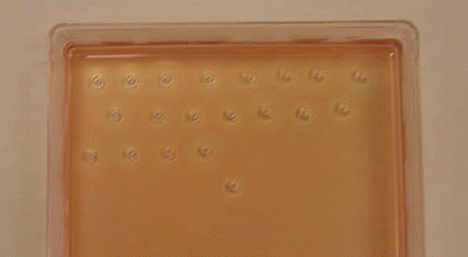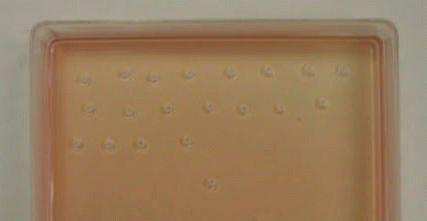

6. Single Radial Haemolysis
Single radial haemolysis (SRH) is routinely used for the detection of rubella-specific IgG. Many sera can be examined simultaneously for evidence of immunity by this technique. SRH has been shown to be both sensitive, specific, and reliable. SRH plates are usually prepared in the laboratory using commercially available reagents, since the short shelf life of the gels makes commercial distribution difficult. Test sera are placed in wells on a plate containing agar with rubella antigen-coated rbc and complement. The presence of rubella-specific IgG is detected by the lysis of rubella antigen-coated RBC. The zone of lysis around the well is dependent on the level of specific antibody present. Besides screening for immunity, SRH can also be used for the diagnosis of acute infection where an increase in the zone size of haemolysis can be demonstrated between acute and convalescent sera. SRH has also been developed for other virus infections such as mumps. However, its main use remains in the screening for immunity against rubella.
SRH plates are prepared as follows. 1% molten agarose is used. Rubella antigen-sensitized sheep rbcs is added to the test plate and unsensitized sheep rbcs to the control plate. Complement is then added to the plates and the molten agarose is allowed to set. The plates are then stored at 4oC until use. Wells are then cut on the test and control plates and serum is added to one well on the test plate and a corresponding well on the control plate. A negative control, a 15 IU/ml control, and a high positive control are used. The plates are then incubated in a moist chamber at 37oC overnight.
The size of the zone of haemolysis around a well containing test serum is compared to that of the 15 IU/ml control. If the zone size is greater than the 15 IU/ml control, then the person is considered to be immune. No zone of non-specific haemolysis should be present on the control plate. Hazy zones of haemolysis may also occur when acute phase sera are tested due to the presence of low avidity antibodies. Some women fail to produce antibody level of greater than 15 IU/ml even after several vaccinations, therefore many laboratories consider women with a well- documented history of more than one vaccination to be immune, if antibodies are detected by another assay.
Besides SRH, other tests such as ELISA and latex agglutination are also widely used for the screening of rubella antibodies. Sera from patients whose immune status is difficult to determine by SRH may give a clear-cut result with ELISA. Latex agglutination tests have the advantage of speed and simplicity and the technique is also very sensitive. Therefore LA is now used as the screening test for rubella antibodies in many laboratories in preference to SRH.
 |
 |
Single Radial Haemolysis for rubella antibody. Test-plate (L),
Control Plate (R). The well in the middle of the plate contains
the 15 miu/ml control serum. Note the clear zone of lysis
surrounding the well on the test plate which is absent on the
control plate. Specimens which gives a zone of lysis equal or
greater than the 15 miu/ml control well are regarded as positive
for rubella antibody. Should a zone of similar size is present on
the control plate, then the result is not valid.